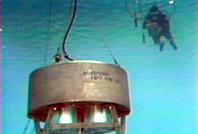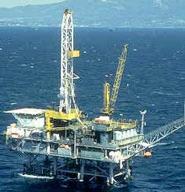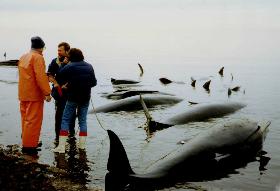|
"Remarkably few details are known about the characteristics of ocean noise, whether it be of human or natural origin, and much less is understood of the impact of noise on the short and long term well being of marine mammals and the ecosystems on which they depend," the report's authors wrote.
Marine researchers are concerned about the lack of knowledge about the effects of noise from the growing number of ships and oil rigs, from marine and coastal development, as well as the increased use of sonar by navies and researchers.
Noise levels from ship traffic have increased some 15 decibels in the last 50 years, but it is difficult to know whether sound levels are continuing to increase, as newer ships may be quieter.
The global shipping fleet increased from 30,000 commercial vessels in 1950 to 87,000 in 1998, but "consequent noise changes cannot be determined because noise data were not collected in a systemic way to allow for scientific comparisons, nor are they being systemically collected at this time," the report states.
"Similar needs exist for every facet of human activity in the oceans," the authors wrote.
Existing information on noise levels is scattered among shipping companies, oil and gas businesses, academic institutions and the military. The report recommends that one agency gather all existing data into one comprehensive database, and initiate a long term program to monitor sound in the sea, targeting important marine mammal habitats such as coastal areas and known migration paths, feeding grounds and breeding areas.
A test of the Navy's Surveillance Towed Array
Sensor System Low Frequency Active sonar
(SURTASS-LFA) (Photo courtesy U.S. Navy)
There is also a need for more investigation into possible links between the use of high energy, midrange sonar and mass strandings of marine animals, according to the report.
Beaked whales in particular have suffered trauma and mass strandings near where naval sonar was being used, the authors said, but they noted that there is not enough data to determine whether the sonar caused the strandings.
"It is important to determine whether there is any connection between sonar use and beachings," they wrote, "and if so, whether this link is peculiar to beaked whales or if other sea species may be affected as well."
A growing body of evidence does correlate naval use of sonar to an array of strandings by beaked whales and other marine life.
In 1996, 12 beaked whales were stranded in Greece during NATO exercises in the Mediterranean Sea using low frequency sonar. And the U.S. Navy and the U.S. National Marine Fisheries Service have acknowledged that the Navy's tactical sonar played a role in the strandings of 17 marine mammals in the Bahamas in 2000.
Ocean going vessels, like this Royal Caribbean vessel
outside the port of Miami, Florida, produce a variety
of noises that may disturb whales and dolphins.
(Photo courtesy Royal Caribbean International)
Military operations are not the only activities receiving criticism for using sonar that may have a harmful affect on marine life. Last fall, National Science Foundation researchers were forced by a court order to halt the use of high decibel air guns for a project to map a fault in the Earth's crust.
Environmentalists filed suit for the court order after the discovery of two dead beaked whales, which stranded themselves on an island in the Gulf of California near where the air gun had been used.
Last month, a federal judge issued a permanent injunction
barring testing of a controversial sonar system designed to
test whether sound pulses could keep migrating gray
whales away from shipping lanes. The judge said the testing
of high frequency sonar pulses, designed by the Woods Hole
Oceanographic Institute, might harm the whales.
Marine mammals are extremely sensitive to noise, which is
one reason why researchers are desperate to better understand
how human generated sounds may be affecting them.
|




